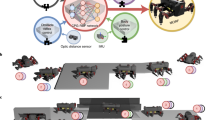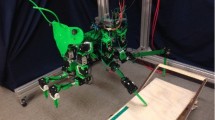Abstract
The aim was to investigate a method of developing mobile robot controllers based on ideas about how plastic neural systems adapt to their environment by extracting regularities from the amalgamated behavior of inflexible (nonplastic) innate subsystems interacting with the world. Incremental bootstrapping of neural network controllers was examined. The objective was twofold. First, to develop and evaluate the use of prewired or innate robot controllers to bootstrap backpropagation learning for Multilayer Perceptron (MLP) controllers. Second, to develop and evaluate a new MLP controller trained on the back of another bootstrapped controller. The experimental hypothesis was that MLPs would improve on the performance of controllers used to train them. The performances of the innate and bootstrapped MLP controllers were compared in eight experiments on the tasks of avoiding obstacles and finding goals. Four quantitative measures were employed: the number of sensorimotor loops required to complete a task; the distance traveled; the mean distance from walls and obstacles; the smoothness of travel. The overall pattern of results from statistical analyses of these quantities supported the hypothesis; the MLP controllers completed the tasks faster, smoother, and steered further from obstacles and walls than their innate teachers. In particular, a single MLP controller incrementally bootstrapped by a MLP subsumption controller was superior to the others.
Similar content being viewed by others
Explore related subjects
Discover the latest articles, news and stories from top researchers in related subjects.References
Anderson, T.L. and Donath, M. 1990. Animal behavior as a paradigm for developing robot autonomy. Robotics and Autonomous Systems, 6:145-168.
Bekey, G.A. and Goldberg, K.Y. (Eds.). 1993. Neural Networks in Robotics, Kluwer: Boston, MA.
Benhamou, S., Sauve, J.P., and Bovet, P. 1990. Spatial memory in large scale movements: Efficiency and limitations of the egocentric coding process. Journal of Theoretical Biology, 145:1-12.
Brooks, R.A. 1986. A robust layered control system for a mobile robot. IEEE Journal of Robotics and Automation, RA-2:14-23.
Carthy, J.D. 1963. Animal Navigation, 3rd edition, Unwin Books: London, UK.
Collett, T.S. 1996. Insect navigation en route to the goal: Multiple strategies for the use of landmarks. Journal of Experimental Biology, 199:227-235.
del Millan, J. 1996. Rapid, safe, and incremental learning of navigation strategies. IEEE Transactions on Systems, Man, and Cybernetics, Part B: Cybernetics, 26(3):408-420.
Donnart, J.I. and Meyer, J.A. 1996. Learning reactive and planning rules in a motivationally autonomous animat. IEEE Transactions on Systems, Man, and Cybernetics, Part B: Cybernetics. Special issue on Learning autonomous robots, 26(3):381-395.
Dorigo, M. (Ed.). 1996. Special issue on learning autonomous robots. IEEE Transactions on Systems, Man, and Cybernetics, Part B: Cybernetics, 26(3).
Esch, H.E. and Burns, J.E. 1996. Distance estimation by foraging honeybees. Journal of Experimental Biology, 199:155-162.
Etienne, A.S., Maurer, R., and Seguinot, V. 1996. Path integration in mammals and its interaction with visual landmarks. Journal of Experimental Biology, 199:201-209.
Floreano, D. and Mondada, F. 1996. Evolution of homing navigation in a real mobile robot. IEEE Transactions on Systems, Man, and Cybernetics, Part B: Cybernetics. Special issue on Learning autonomous robots, 26(3):396-407.
Gallistel, C.R. 1990. The Organization of Learning, MIT Press: Cambridge, MA.
Gould, J.L. 1986. The locale map of honey bees: do insects have cognitive maps? Science, 232:861-863.
Johnson, M.H. 1992. Imprinting and the development of face recognition: From chick to man. Current Directions in Psychological Science, 1:52-55.
Johnson, M.H. and Bolhuis, J.J. 1991. Imprinting, predispositions and filial preference in the chick. In Neural and Behavioural Plasticity, R.J. Andrew (Ed.), Oxford University Press: Oxford, UK.
Kassim, A.A. and Kumar, B.V.K.V. 1995. Potential fields and neural networks. In The Handbook of Brain Theory and Neural Networks, M.A. Arbib (Ed.), MIT Press: Cambridge, MA.
Khatib, O. 1986. Real-time obstacle avoidance for manipulators and mobile robots. International Journal of Robotics Research, 5:90-98.
Krose, B. (Ed.). 1995. Special issue on reinforcement learning and robotics. Robotics and Autonomous Systems, 15.
McCulloch, W.A. and Pitts, W. 1943. A logical calculus of the ideas immanent in nervous activity. Bulletin of Mathematical Biophysics, 5:115-133.
Meeden, L.A. 1996. An incremental approach to developing intelligent neural network controllers for robots. IEEE Transactions on Systems, Man, and Cybernetics, Part B: Cybernetics, 26(3):474- 485.
Nolfi, S. 1997. Evolving non-trivial behaviors on a real robot: A garbage collecting robot. Robotics and Autonomous Systems, 22.
Nolfi, S. and Parisi, D. 1997. Learning to adapt to changing environments in evolving neural networks. Adaptive Behavior, 5:75-98.
Owen, C. and Nehmzow, U. 1997. Middle scale robot navigation— A case study. In Proceedings of the AISB Workshop on Spatial Reasoning in Mobile Robots and Animals, N.E. Sharkey and U. Nehmzow (Eds.), Dept. Computer Science Technical report UMCS-97-4-1; Manchester University, pp. 104-111.
Salomon, R. 1997. The evolution of different neuronal control structures fo autonomous agents. Robotics and Autonomous Systems, 22.
Sharkey, N.E. 1997a. The new wave in robot learning. Robotics and Autonomous Systems, 22.
Sharkey, N.E. 1997b. Artificial neural networks for coodination and control: The portability of experiential representations. Robotics and Autonomous Systems, 22.
Sharkey, N.E. and Sharkey, A.J.C. 1994. Emergent cognition. Handbook of Neuropsychology, 9:347-360.
Sharkey, N.E., Heemskerk, J.N.H., and Neary, J. 1996a. Subsuming behaviors in neural network controllers. In Proceedings of Robolearn-96: An International Workshop on Learning for Autonomous Robots, H. Hexmoor and L. Meeden (Eds.), Key West, Florida, pp. 98-104.
Sharkey, N.E., Heemskerk, J.N.H., and Neary, J. 1996b. Training artificial neural networks for robot control. In Solving engineering problems with neural networks, A.B. Bulsari, S. Kallio, and D. Tsaptsinos (Eds.), Systems Engineering Association, London.
Sharkey, N.E. and Heemskerk, J.N.H. 1997. The neural mind and the robot. In Neural Network Perspective on Cognition and Adaptive Robotics, A.J. Browne (Ed.), Institute of Physics Press: London.
Srinivasan, M.C., Zhang, S.W., Lehrer, M., and Collett, T.S. 1996. Honeybee navigation en route to the goal: Visual flight control and odometry. Journal of Experimental Biology, 199:127-244.
Touzet, C. 1997. Neural reinforcement learning for behavior synthesis. Robotics and Autonomous Systems, 22.
von Frisch, K. 1967. Honeybees: Do they use direction and distance information provided by their dancers? Science, 158:1076-1077.
Walter, G.W. 1950. An imitation of life. Scientific American, 182: 42-54.
Walter, G.W. 1953. The Living Brain, Norton: New York.
Wehner, R. 1992. Arthropods. In Animal Homing, F. Papi (Ed.), Chapman and Hall: London, UK.
Wehner, R., Michel, B., and Antonsen, P. 1996. Visual navigation in insects: Coupling of egocentric and geocentric information. Journal of Experimental Biology, 199:129-140.
Author information
Authors and Affiliations
Rights and permissions
About this article
Cite this article
Sharkey, N.E. Learning from Innate Behaviors: A Quantitative Evaluation of Neural Network Controllers. Autonomous Robots 5, 317–334 (1998). https://doi.org/10.1023/A:1008862423185
Issue Date:
DOI: https://doi.org/10.1023/A:1008862423185




